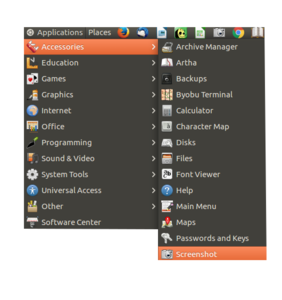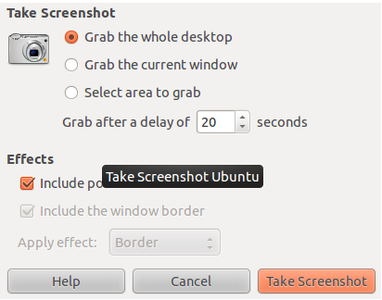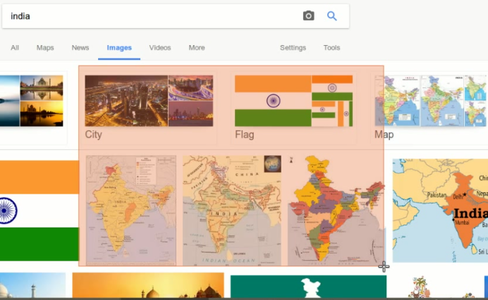Difference between revisions of "Learn Screenshot"
| (25 intermediate revisions by 7 users not shown) | |||
| Line 1: | Line 1: | ||
| − | + | ''[http://karnatakaeducation.org.in/KOER/index.php/%E0%B2%B8%E0%B3%8D%E0%B2%95%E0%B3%8D%E0%B2%B0%E0%B3%80%E0%B2%A8%E0%B3%8D_%E0%B2%B6%E0%B2%BE%E0%B2%9F%E0%B3%8D_%E0%B2%95%E0%B2%B2%E0%B2%BF%E0%B2%AF%E0%B2%BF%E0%B2%B0%E0%B2%BF ಕನ್ನಡದಲ್ಲಿ ನೋಡಿ]'' | |
| − | + | {{Template:Book-sidebar}} | |
| − | + | ===Introduction=== | |
| − | + | "Screenshot" is the term used to describe the action of capturing your computer desktop or anything shown on your computer screen to a static image file. | |
| − | + | ====Basic information==== | |
| − | =Introduction= | ||
| − | |||
| − | |||
| − | |||
| − | |||
| − | |||
| − | |||
| − | |||
| − | |||
| − | |||
| − | |||
| − | |||
| − | |||
| − | == | ||
| − | |||
| − | |||
| − | == | ||
| − | |||
| − | |||
| − | |||
| − | |||
| − | |||
| − | |||
| − | |||
| − | |||
| − | |||
| − | |||
| − | |||
{| class="wikitable" | {| class="wikitable" | ||
|- | |- | ||
| − | | | + | |ICT Competency |
| − | | | + | |Screenshot is a Free and open source software application that can be used for creating graphics for resource creation. |
| + | |- | ||
| + | |Educational application and relevance | ||
| + | |Screenshot can be very helpful when you want to demonstrate something that would be difficult to explain in words. | ||
| + | Screenshots can be used to demonstrate a program, a particular problem a user might be having, or generally when display output needs to be shown to others | ||
| + | |- | ||
| + | |Version | ||
| + | |3.18.0 version. | ||
| + | |- | ||
| + | |Configuration | ||
| + | |No specific configuration requirements. | ||
| + | |- | ||
| + | |Other similar applications | ||
| + | | | ||
| + | *[https://monosnap.com/welcome Monosnap] , [https://web-capture.net/ Web Capture], [http://jetscreenshot.com/ Jet Screenshot] | ||
|- | |- | ||
| − | | | + | |The application on mobiles and tablets |
| − | + | |'''Screenshot''' manages to capture the screen of simple to Android '''mobile''' phone. | |
| − | # | + | There are many apps available in Android play store. few are listed here:- |
| − | # | + | # Screenshot |
| − | + | # Touchshot | |
| + | # Screenshot Touch | ||
| + | # Quick Screenshot | ||
| − | + | In any Android mobile, if you press and hold the '''Power key''', it will give you a Screenshot option. | |
| − | |||
| − | |||
| − | |||
|- | |- | ||
| − | | | + | |Development and community help |
| | | | ||
| + | *[https://www.take-a-screenshot.org/ Official Website] | ||
|} | |} | ||
| + | ====Overview of Features==== | ||
| + | The screenshot application allows you to save snippets of anything you have on your screen - whether static or dynamic. The screenshot of a video, will be a still snapshot. Screenshot will capture the images matching the resolution of your computer. Screenshot images can be edited and used for creating resources. The Screenshot application in Ubuntu allows you different options for taking screenshots, discussed below. | ||
| + | ====Installation==== | ||
| + | #The application is part of the Ubuntu custom distribution. | ||
| + | #In case you do not find it on your computer, you can install by typing <code>Screenshot</code> on top search bar in Software Centre. | ||
| + | #If you would like to install through the terminal follow these steps below: | ||
| + | ##Open terminal by clicking Applications->System Tools->Terminal or through Keyboard shortcut <code>Ctrl+Alt+T</code> | ||
| + | ##In the terminal window, type below command and press enter to start the installation by providing your machine password: | ||
| + | ##<code>sudo apt-get install screenshot</code> | ||
| − | == | + | ===Working with the application=== |
| + | ====Use Print Screen==== | ||
| + | This is the most common method to take Screenshot. Pressing the “Print Screen” button will take the Screenshot of the “Entire Visible Screen”. | ||
| + | ====Using Accessories from the Ubuntu applications menu==== | ||
| + | You can also generate open the screenshot application from Applications--->Accessories--->Screenshot. | ||
| + | <gallery mode="packed" heights="200px" caption="Using Screenshot to capture images from your screen"> | ||
| + | File:Screen_Shot_1.png|Opening Screenshot | ||
| + | File:Screenshot 2.png|Options to select area | ||
| + | File:Selection.png|Select area to grab | ||
| + | </gallery> | ||
| + | #To open "Screenshot" go to '''Application-Accessories-Screenshot'''. see above image. | ||
| + | #Once you click on the Screenshot option. it open the above window. Here there will be three options to take pictures. | ||
| + | ##'''Grab the whole desktop''' -To take a Screenshot with entire screen, select “Grab the whole desktop” and click “Take Screenshot”. | ||
| + | ##'''Grab the Current Window'''-To take the Screenshot of the current active window alone, select “Grab the Current Window” and click “Take Screenshot”. | ||
| + | ##Both the above two options allow you to grab the screen after a time delay of a defined number of seconds. This is useful when we need to take screen shots of the different tool bar functionalities and demonstrate the changes from different commands in an application. This is also useful when you want to take screenshots of dynamic displays - like an animation or video or simulation. | ||
| + | ##'''Select Area to Grab'''- To take a particular rectangle area alone, select “Select Area to Grab” and click “Take Screenshot”. You will need to mark out a rectangle on the screen, which will be covered by the Screenshot. Begin at the one end and move to the diagonally opposite end, to complete the rectangle, keeping the left mouse click pressed. When you reach the diagonally opposite end, release the mouse to complete the rectangle, which will be the 'area' of the Screenshot.Supposing you are playing a video on one part of the screen and you want only the video to be captured, you can use this feature, to take a photo of the video (which will be the image which is displayed in the video at the time of the taking of the screen shot. | ||
| − | ==Saving the | + | ====Saving the files and formats==== |
| + | [[File:Save screenshot.png|left|Save Screenshot]] | ||
| + | Once you click on '''Take Screenshot''', the picture of the screen will be taken and you will be shown a Save-->Dialog box. Screenshots will be saved in the Pictures folder by default. The application will also name the file as Screenshot....date..time.png. You can edit the file name as required and save. Screenshot images will be saved in .png format. | ||
| + | {{clear}} | ||
| − | == | + | ====Advanced features==== |
| + | #Timed captures to allow you prepare the work space (desktop) before capturing the image. | ||
| + | #Options to include or exclude the mouse cursor. The mouse cursor can be used to point out a particular point in your image. | ||
| − | == | + | ===Ideas for resource creation=== |
| − | + | You can take a picture of your screen (a screenshot). This is useful if you want to show someone how to do something on the computer, for example. Screenshot are just normal picture files, so you can email them and share them on the web. | |
| − | |||
| − | |||
| − | |||
| − | |||
| − | |||
| − | |||
| − | |||
| − | |||
| − | |||
| − | |||
| − | |||
| − | |||
| − | |||
| − | |||
| − | |||
| − | |||
| − | |||
| − | = | + | ===References=== |
| + | [https://en.wikipedia.org/wiki/Screenshot Wikipedia] | ||
| − | + | [[Category:Explore an application]] | |
Latest revision as of 07:48, 26 November 2018
Introduction
"Screenshot" is the term used to describe the action of capturing your computer desktop or anything shown on your computer screen to a static image file.
Basic information
| ICT Competency | Screenshot is a Free and open source software application that can be used for creating graphics for resource creation. |
| Educational application and relevance | Screenshot can be very helpful when you want to demonstrate something that would be difficult to explain in words.
Screenshots can be used to demonstrate a program, a particular problem a user might be having, or generally when display output needs to be shown to others |
| Version | 3.18.0 version. |
| Configuration | No specific configuration requirements. |
| Other similar applications | |
| The application on mobiles and tablets | Screenshot manages to capture the screen of simple to Android mobile phone.
There are many apps available in Android play store. few are listed here:-
In any Android mobile, if you press and hold the Power key, it will give you a Screenshot option. |
| Development and community help |
Overview of Features
The screenshot application allows you to save snippets of anything you have on your screen - whether static or dynamic. The screenshot of a video, will be a still snapshot. Screenshot will capture the images matching the resolution of your computer. Screenshot images can be edited and used for creating resources. The Screenshot application in Ubuntu allows you different options for taking screenshots, discussed below.
Installation
- The application is part of the Ubuntu custom distribution.
- In case you do not find it on your computer, you can install by typing
Screenshoton top search bar in Software Centre. - If you would like to install through the terminal follow these steps below:
- Open terminal by clicking Applications->System Tools->Terminal or through Keyboard shortcut
Ctrl+Alt+T - In the terminal window, type below command and press enter to start the installation by providing your machine password:
sudo apt-get install screenshot
- Open terminal by clicking Applications->System Tools->Terminal or through Keyboard shortcut
Working with the application
Use Print Screen
This is the most common method to take Screenshot. Pressing the “Print Screen” button will take the Screenshot of the “Entire Visible Screen”.
You can also generate open the screenshot application from Applications--->Accessories--->Screenshot.
- Using Screenshot to capture images from your screen
- To open "Screenshot" go to Application-Accessories-Screenshot. see above image.
- Once you click on the Screenshot option. it open the above window. Here there will be three options to take pictures.
- Grab the whole desktop -To take a Screenshot with entire screen, select “Grab the whole desktop” and click “Take Screenshot”.
- Grab the Current Window-To take the Screenshot of the current active window alone, select “Grab the Current Window” and click “Take Screenshot”.
- Both the above two options allow you to grab the screen after a time delay of a defined number of seconds. This is useful when we need to take screen shots of the different tool bar functionalities and demonstrate the changes from different commands in an application. This is also useful when you want to take screenshots of dynamic displays - like an animation or video or simulation.
- Select Area to Grab- To take a particular rectangle area alone, select “Select Area to Grab” and click “Take Screenshot”. You will need to mark out a rectangle on the screen, which will be covered by the Screenshot. Begin at the one end and move to the diagonally opposite end, to complete the rectangle, keeping the left mouse click pressed. When you reach the diagonally opposite end, release the mouse to complete the rectangle, which will be the 'area' of the Screenshot.Supposing you are playing a video on one part of the screen and you want only the video to be captured, you can use this feature, to take a photo of the video (which will be the image which is displayed in the video at the time of the taking of the screen shot.
Saving the files and formats
Once you click on Take Screenshot, the picture of the screen will be taken and you will be shown a Save-->Dialog box. Screenshots will be saved in the Pictures folder by default. The application will also name the file as Screenshot....date..time.png. You can edit the file name as required and save. Screenshot images will be saved in .png format.
Advanced features
- Timed captures to allow you prepare the work space (desktop) before capturing the image.
- Options to include or exclude the mouse cursor. The mouse cursor can be used to point out a particular point in your image.
Ideas for resource creation
You can take a picture of your screen (a screenshot). This is useful if you want to show someone how to do something on the computer, for example. Screenshot are just normal picture files, so you can email them and share them on the web.




